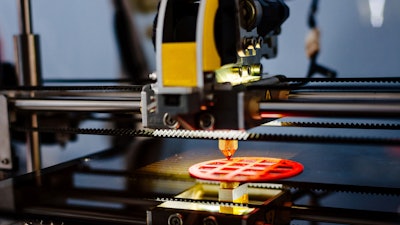
Manufacturers are increasingly adopting additive technologies, such as binder jetting or fused deposition modeling, to accelerate prototyping, reduce raw material consumption, and cut down inventory costs. According to Precedence Research, the additive manufacturing market, valued at $15 billion in 2022, will reach $95.62 billion by 2032, showing a CAGR of 20.4 percent throughout the forecast period.
However, additive manufacturing companies must accelerate and optimize their disparate processes, such as prototyping, inventory management, production scheduling, and preventive maintenance to achieve the tangible benefits mentioned earlier. One of the ways for companies to facilitate that is to adopt a manufacturing ERP system equipped with the proper functionality.
This article covers five ERP features that have proved helpful in driving the efficiency of additive manufacturing.
Machinery Integration
Running and maintaining multiple 3D printers simultaneously has already become routine among companies using additive manufacturing technologies. For instance, thyssenkrupp BILSTEIN, a global auto parts manufacturer, operates ten Raise3D printers at its Hamilton site, which is only one of nine operating locations. If done manually, equipment management can be tricky and labor-intensive.
Thus, many companies aim to automate and optimize this business aspect with specialized software, and manufacturing ERP solutions can come in handy here. Industrial 3D printers are equipped with multiple IoT sensors that collect various data on equipment performance, such as temperature, vibration level, or machine downtime. ERP systems consolidate actual and historical machinery data captured with IoT devices, which helps managers analyze it to plan and schedule maintenance activities, create and submit MRO inventory purchase orders, and plan production capacity accordingly.
Some hardware vendors provide proprietary digital tools for connecting corporate software and machinery, simplifying integration. For example, a provider of additive manufacturing hardware, Stratasys, offers an SDK that includes technical documentation and application programming interfaces, thus helping clients integrate machinery with ERPs and other enterprise systems. Otherwise, companies must use third-party integration solutions, or develop custom integrations from scratch.
Inventory Management
One of the main reasons for switching to additive technologies is reducing material usage, which in turn allows manufacturers to cut down production costs. Companies can maximize this business advantage by implementing ERP with inventory management capabilities, as it helps manage unused powders and materials more efficiently.
For instance, employees can use ERP's inventory tracking feature to track raw materials across a company's supply chain and facilities, such as warehouses and shop floors, based on unique IDs attributed to each SKU. With such end-to-end visibility, companies can distribute inventory across various production sites more efficiently, thus avoiding production downtime due to raw material shortages. Moreover, employees can use ERPs to track the expiration dates of raw materials and monitor the disposition of expired and non-conforming inventory to minimize its costs and deadstock.
eSourcing and eProcurement
Given that ERPs integrate real-time inventory data, such systems can alert procurement teams if a particular material or part is running short. ERPs with automated sourcing and procurement features can generate requests for quotes (RFQs) and requests for proposals (RFPs) and send them to suppliers with little or no human intervention, accelerating inventory replenishment.
Quality Management and Control
Additive technologies allow manufacturers to build more endurable yet lightweight products that would be difficult to create with traditional techniques such as plastic joining or injection molding. However, ensuring product quality remains challenging for manufacturers, especially in high-technology areas such as healthcare, aerospace or communications equipment.
Implementing ERP software with quality management capabilities allows companies to mitigate it. For example, ERP systems enable manufacturers to analyze customer complaints about products built with raw materials from certain suppliers to identify low-quality materials and act accordingly. In addition, companies can analyze quality test data to improve a product's formula and, consequently, enhance customer satisfaction.
Human Resource Management
Implementing additive manufacturing can disrupt traditional manufacturing processes, which in turn can negatively affect employee productivity, as they have to adapt to new workflows and learn to use 3D printing equipment effectively. Implementing a manufacturing ERP with HRM capabilities, such as employee performance tracking and training management, can help companies mitigate this challenge.
With performance tracking capabilities, companies can track parameters such as the number of units produced, the number of defects, and lead time to evaluate the performance of any individual team member. This way, supervisors can gain an overview of a manufacturing teams' performance and identify areas of their work that require improvement.
The built-in training management functionality also allows managers to centrally distribute learning materials among employees and evaluate their training progress. This advantage enables additive manufacturing companies to close skill gaps more quickly and improve overall business performance.
Data Analytics
With a built-in analytics module, an ERP system can help companies generate data insights for optimizing 3D printing workflows, and prototyping is one of the examples. To be more specific, engineers can use ERP coupled with ML-powered analytics to identify shortcomings in 3D models, which helps speed up prototyping and reduce the risk of product defects.
Additionally, manufacturers can implement ERPs with advanced analytics capabilities to predict future business trends. For example, they can analyze historical sales data combined with news feeds or social media sentiment to predict consumer demand and optimize production plans.
Introducing a comprehensive manufacturing ERP solution that automates and continuously optimizes core business processes helps a company accelerate additive manufacturing transformation.
The success of the ERP project starts with choosing a reliable ERP technology partner that can help a company speed up implementation and maximize technology investments. Professional ERP developers can handle the technical aspect, namely coding, and ensure that employees are properly trained to use the solution, which can help a manufacturer minimize business disruption.






















